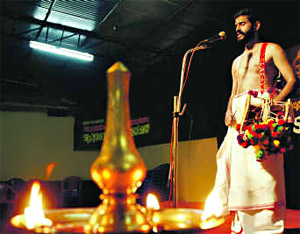 Sopana Sangeetham is a form of Indian classical music that developed in South India in the backdrop of increasing popularity of Jayadeva`s Gita Govinda. Sopana Sangeetham is derived from two Sanskrit words: Sopanam and Sangeetham. Sopanam means the sacred steps of a temple and Sangeetham is music.
Sopana Sangeetham is a form of Indian classical music that developed in South India in the backdrop of increasing popularity of Jayadeva`s Gita Govinda. Sopana Sangeetham is derived from two Sanskrit words: Sopanam and Sangeetham. Sopanam means the sacred steps of a temple and Sangeetham is music.
Performance of Sopana Sangeetham
Sopana sangeetham is sung by the side of the steps that leads to the inner chamber of a temple. As per tradition, this is sung by men of Marar and Pothuval castes of Ambalavasi community engaged to do it as their hereditary profession.
Sopana sangeetham is a product of a happy blending of the Vedic, folk and tribal music of Kerala. The distinct ragas used in this are Puraneera, Indalam, Kanakurinhi, Sreekanti, Ghantaram and Samantamalahari. However, it has a lot of ragas that are used in the Carnatic music. Sopanam follows an uncomplicated plain-note profile or Aantolika gamakam and has no microtones. It has an introductory segment known as alapanam which is followed by the song.
It also has ragas that are prescribed for recitation during a particular time of the day. The structure of this genre reflects the experience of the devotee in attaining devotional heights. It has its beginnings in the practice of singing invocations in front of the `Kalam` of Goddess Kali.
Instruments of Sopana Sangeetham
Sopana Sangeetham is sung in plain notes that are accompanied by the small, hour glass-shaped ethnic drum known as `edakka` or idakka, along with the chengila (metallic gong) for the beats.
Training of Sopana Sangeetham
This form of music is traditionally taught by the family members to the next generation. However, in the present days there is a certified institute called Kshetra Kala Peetham in the temple town of Vaikom that educates students in Sopanam. Sopana Sangeetham also has its set of schools and this include ones that are being sung at south Kerala temples like Pazhoor and Ramamangalam and the northern temples like Thirumandhamkunnu and Guruvayoor.
Experts of Sopana Sangeetham
Some of the experts of Sopana Sangeetham include the late Njeralattu Rama Poduval of Thirumandhamkunnu bani, Janardhanan Nedungadi of Guruvayoor and Damodara Marar, Pallavoor Kunhukutta Marar. The rendition style of Sopanam extends to providing audio accompaniment to Kerala dance-dramas like Kathakali, Krishnanattam and Ashtapadiyattam and in devotional music like Kalam pattu and dramatic music in Mudiyettu.




















